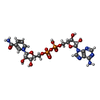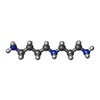+Search query
-Structure paper
| Title | Structural Insights into the Mechanism of Mitoribosomal Large Subunit Biogenesis. |
|---|---|
| Journal, issue, pages | Mol Cell, Vol. 79, Issue 4, Page 629-644.e4, Year 2020 |
| Publish date | Aug 20, 2020 |
 Authors Authors | Mateusz Jaskolowski / David J F Ramrath / Philipp Bieri / Moritz Niemann / Simone Mattei / Salvatore Calderaro / Marc Leibundgut / Elke K Horn / Daniel Boehringer / André Schneider / Nenad Ban /  |
| PubMed Abstract | In contrast to the bacterial translation machinery, mitoribosomes and mitochondrial translation factors are highly divergent in terms of composition and architecture. There is increasing evidence ...In contrast to the bacterial translation machinery, mitoribosomes and mitochondrial translation factors are highly divergent in terms of composition and architecture. There is increasing evidence that the biogenesis of mitoribosomes is an intricate pathway, involving many assembly factors. To better understand this process, we investigated native assembly intermediates of the mitoribosomal large subunit from the human parasite Trypanosoma brucei using cryo-electron microscopy. We identify 28 assembly factors, 6 of which are homologous to bacterial and eukaryotic ribosome assembly factors. They interact with the partially folded rRNA by specifically recognizing functionally important regions such as the peptidyltransferase center. The architectural and compositional comparison of the assembly intermediates indicates a stepwise modular assembly process, during which the rRNA folds toward its mature state. During the process, several conserved GTPases and a helicase form highly intertwined interaction networks that stabilize distinct assembly intermediates. The presented structures provide general insights into mitoribosomal maturation. |
 External links External links |  Mol Cell / Mol Cell /  PubMed:32679035 PubMed:32679035 |
| Methods | EM (single particle) |
| Resolution | 3.1 - 3.9 Å |
| Structure data | EMDB-10999, PDB-6yxx: EMDB-11000, PDB-6yxy: |
| Chemicals |  ChemComp-ZN:  ChemComp-MG:  ChemComp-GTP:  ChemComp-NA:  ChemComp-ATP:  ChemComp-PM8:  ChemComp-NAD:  ChemComp-HOH:  ChemComp-SPD: |
| Source |
|
 Keywords Keywords |  RIBOSOME / RIBOSOME /  mitoribosome / assembly / LSU mitoribosome / assembly / LSU |
 Movie
Movie Controller
Controller Structure viewers
Structure viewers About Yorodumi Papers
About Yorodumi Papers








